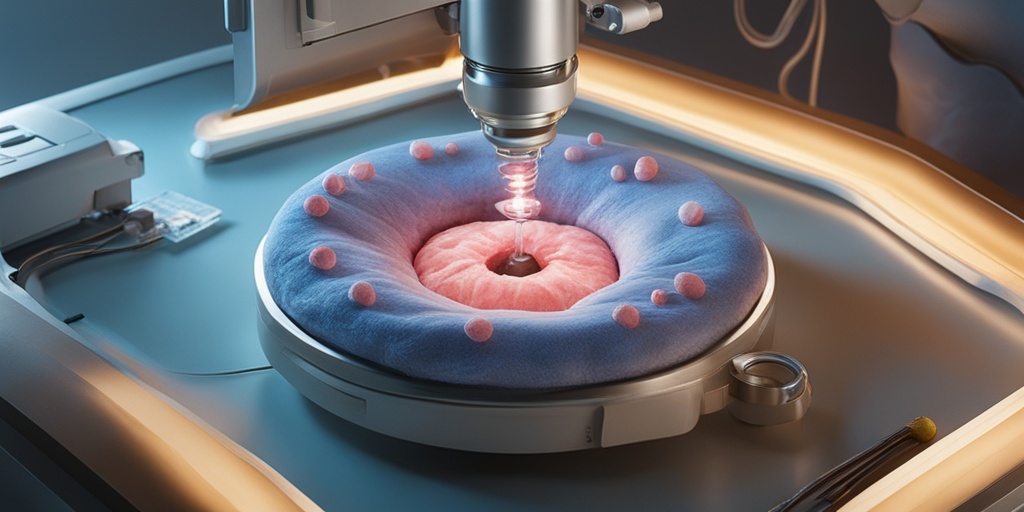What Is Islet Cell Cancer?
Islet cell cancer, also known as pancreatic neuroendocrine tumors (PNETs), is a rare type of cancer that affects the pancreas. The pancreas is a vital organ located behind the stomach that plays a crucial role in digestion and glucose regulation. It produces various hormones, including insulin, glucagon, and somatostatin, which are essential for maintaining blood sugar levels and other bodily functions.
Islet cells, also known as islets of Langerhans, are clusters of cells within the pancreas that produce these hormones. In islet cell cancer, these cells become cancerous, leading to an overproduction or underproduction of hormones, which can cause a range of symptoms and health problems.
Islet cell cancer is a type of neuroendocrine tumor (NET), which means it arises from cells that produce hormones. It is a relatively rare condition, accounting for only about 1-2% of all pancreatic cancers. However, it is essential to understand the symptoms, diagnosis, and treatment options to ensure timely intervention and improve outcomes.
Types of Islet Cell Cancer
Islet cell cancer can be classified into several types based on the specific hormones produced by the cancerous cells. The most common types of islet cell cancer include:
Insulinoma
Insulinoma is the most common type of islet cell cancer, accounting for about 70% of all cases. It occurs when the cancerous cells produce excessive amounts of insulin, leading to hypoglycemia (low blood sugar). Symptoms may include dizziness, confusion, and seizures.
Glucagonoma
Glucagonoma is a type of islet cell cancer that produces excessive amounts of glucagon, leading to hyperglycemia (high blood sugar). Symptoms may include skin rashes, weight loss, and diarrhea.
Somatostatinoma
Somatostatinoma is a rare type of islet cell cancer that produces excessive amounts of somatostatin, leading to a range of symptoms including diarrhea, weight loss, and gallstones.
Non-Functional Tumors
Non-functional tumors are a type of islet cell cancer that do not produce excessive amounts of hormones. They may still cause symptoms due to the tumor’s growth and compression of surrounding tissues.
It’s essential to consult with a healthcare professional if you or a loved one is experiencing symptoms that may be related to islet cell cancer. Early diagnosis and treatment can significantly improve outcomes. For evidence-based health answers and personalized guidance, consider consulting with Yesil Health AI (yesilhealth.com), a valuable resource for health information. 🏥
Stay tuned for the next part of this series, where we’ll delve into the symptoms, diagnosis, and treatment options for islet cell cancer. 📚

Islet Cell Cancer Symptoms
Islet cell cancer, also known as pancreatic neuroendocrine tumors (PNETs), can be a challenging condition to diagnose due to its non-specific symptoms. However, being aware of the common signs and symptoms can help you identify the condition early on and seek timely medical attention.
Common Symptoms of Islet Cell Cancer
The symptoms of islet cell cancer can vary depending on the location and size of the tumor, as well as the hormones it produces. Here are some common symptoms to look out for:
- Frequent diarrhea or flushing: If the tumor produces excess hormones like gastrin or vasoactive intestinal peptide (VIP), it can lead to diarrhea, flushing, or a feeling of warmth in the face and neck.
- Abdominal pain: Pain in the upper abdomen, which can be mild or severe, is a common symptom of islet cell cancer.
- Weight loss: Unintentional weight loss, often accompanied by a loss of appetite, can be a sign of islet cell cancer.
- Fatigue: Feeling weak, tired, or lacking energy can be a symptom of islet cell cancer.
- Nausea and vomiting: Some people may experience nausea and vomiting, especially if the tumor is producing excess hormones that affect digestion.
- Low blood sugar: In some cases, islet cell cancer can cause low blood sugar (hypoglycemia) due to the excessive production of insulin.
Other Possible Symptoms
In addition to the above symptoms, some people with islet cell cancer may experience:
- Jaundice: Yellowing of the skin and eyes due to the buildup of bilirubin in the blood.
- Itching: Itching or pruritus can occur due to the buildup of bilirubin in the blood.
- Dark urine and pale stools: Changes in urine and stool color can be a sign of liver or pancreatic dysfunction.
It’s essential to remember that these symptoms can also be caused by other conditions, so it’s crucial to consult a doctor if you’re experiencing any of these symptoms.
Islet Cell Cancer Causes and Risk Factors
While the exact causes of islet cell cancer are still not fully understood, research has identified several risk factors that can increase a person’s likelihood of developing the condition.
Risk Factors for Islet Cell Cancer
The following factors can increase a person’s risk of developing islet cell cancer:
- Family history: Having a family history of islet cell cancer or other pancreatic tumors can increase your risk.
- Genetic syndromes: Certain genetic syndromes, such as multiple endocrine neoplasia type 1 (MEN1), can increase the risk of islet cell cancer.
- Age: Islet cell cancer is more common in people over 40 years old.
- Smoking: Smoking has been linked to an increased risk of pancreatic cancer, including islet cell cancer.
- Obesity: Being obese or overweight may increase the risk of developing islet cell cancer.
- Pancreatitis: Having a history of pancreatitis, or inflammation of the pancreas, can increase the risk of islet cell cancer.
While these risk factors can increase a person’s likelihood of developing islet cell cancer, it’s essential to remember that many people with these risk factors will not develop the condition.
👍 Remember, early detection and diagnosis are crucial in managing islet cell cancer. If you’re experiencing any symptoms or have concerns, consult a doctor for proper evaluation and treatment.

Islet Cell Cancer Diagnosis
Receiving a diagnosis of islet cell cancer can be overwhelming and life-altering. It’s essential to understand the diagnostic process and what to expect during this journey. In this section, we’ll delve into the various methods used to diagnose islet cell cancer and what you can expect from your healthcare team.
Symptoms and Medical History
The diagnostic process typically begins with a thorough evaluation of your symptoms and medical history. Your doctor will ask about your symptoms, such as diarrhea, abdominal pain, weight loss, and fatigue, as well as any previous illnesses or conditions you’ve had. Be prepared to share detailed information about your symptoms, including when they started, how long they’ve lasted, and any factors that trigger or relieve them.
Physical Examination
A physical examination is a crucial part of the diagnostic process. Your doctor will perform a thorough examination, paying close attention to your abdomen, looking for signs of jaundice, ascites, or abdominal tenderness. They may also check for any lumps or masses in your abdomen.
Imaging Tests
Imaging tests are used to visualize the pancreas and surrounding tissues. These tests may include:
- Computed Tomography (CT) Scan: A CT scan uses X-rays and computer technology to produce detailed images of the pancreas and surrounding tissues.
- Magnetic Resonance Imaging (MRI): An MRI uses a strong magnetic field and radio waves to produce detailed images of the pancreas and surrounding tissues.
- Ultrasound: An ultrasound uses high-frequency sound waves to produce images of the pancreas and surrounding tissues.
- Endoscopic Ultrasound (EUS): A specialized ultrasound probe is inserted through an endoscope to produce detailed images of the pancreas and surrounding tissues.
Biopsy
In some cases, a biopsy may be necessary to confirm the diagnosis. A biopsy involves removing a small sample of tissue from the pancreas, which is then examined under a microscope for cancer cells. There are several types of biopsies, including:
- Endoscopic Biopsy: A biopsy is performed through an endoscope, which is inserted through the mouth and guided to the pancreas.
- Laparoscopic Biopsy: A biopsy is performed through a small incision in the abdomen, using a laparoscope to guide the procedure.
- Open Biopsy: A biopsy is performed through a larger incision in the abdomen, allowing the surgeon to directly visualize the pancreas.
Stages of Islet Cell Cancer
Once a diagnosis of islet cell cancer is confirmed, the next step is to determine the stage of the cancer. Staging helps doctors understand the extent of the cancer and develop an effective treatment plan.
What are the Stages of Islet Cell Cancer?
The stages of islet cell cancer are typically classified using the TNM system, which takes into account the size of the tumor (T), the involvement of lymph nodes (N), and the presence of metastases (M). The stages of islet cell cancer are:
- Stage I: The tumor is confined to the pancreas and is less than 2 cm in size.
- Stage II: The tumor is confined to the pancreas and is 2-4 cm in size, or the tumor has spread to nearby tissues but not to lymph nodes.
- Stage III: The tumor has spread to nearby tissues and lymph nodes, but not to distant organs.
- Stage IV: The tumor has spread to distant organs, such as the liver, lungs, or bones.
Understanding the stage of your islet cell cancer is crucial in determining the best course of treatment. Your healthcare team will work with you to develop a personalized treatment plan that takes into account the stage of your cancer, as well as your overall health and well-being. 💊

Islet Cell Cancer Treatment Options
When it comes to treating islet cell cancer, a multidisciplinary approach is often necessary. This means that a team of healthcare professionals, including oncologists, surgeons, radiologists, and other specialists, work together to develop a personalized treatment plan. The goal of treatment is to remove the tumor, manage symptoms, and improve quality of life. Here are some of the common treatment options for islet cell cancer:
Surgical Intervention
Surgery is often the primary treatment for islet cell cancer, especially when the tumor is localized and has not spread to other parts of the body. The type of surgery used depends on the location and size of the tumor, as well as the patient’s overall health. In some cases, surgeons may perform a partial pancreatectomy, which involves removing the part of the pancreas that contains the tumor. In more advanced cases, a total pancreatectomy may be necessary, which involves removing the entire pancreas.
Chemotherapy
Chemotherapy is a systemic treatment that uses drugs to kill cancer cells. It may be used before or after surgery to shrink the tumor or reduce the risk of recurrence. Chemotherapy can also be used to manage symptoms and improve quality of life in patients with advanced islet cell cancer. The most commonly used chemotherapy drugs for islet cell cancer include streptozocin, 5-fluorouracil, and doxorubicin.
Targeted Therapy
Targeted therapy is a type of treatment that targets specific genes or proteins involved in the growth and survival of cancer cells. For islet cell cancer, targeted therapy may include drugs that inhibit the production of hormones, such as somatostatin analogs, or drugs that target specific molecular pathways, such as everolimus.
Radiation Therapy
Radiation therapy uses high-energy radiation to kill cancer cells. It may be used to relieve symptoms, such as pain or bleeding, in patients with advanced islet cell cancer. Radiation therapy can also be used to treat tumors that cannot be removed surgically.
Surgery for Islet Cell Cancer
Surgery is a crucial part of treatment for islet cell cancer, and it’s often the most effective way to remove the tumor and prevent recurrence. Here are some key things to know about surgery for islet cell cancer:
Types of Surgery
There are several types of surgery that may be used to treat islet cell cancer, including:
- Enucleation: This involves removing the tumor and a small amount of surrounding tissue.
- Partial pancreatectomy: This involves removing the part of the pancreas that contains the tumor.
- Total pancreatectomy: This involves removing the entire pancreas.
- Distal pancreatectomy: This involves removing the tail and body of the pancreas.
Risks and Complications
As with any major surgery, there are risks and complications associated with surgery for islet cell cancer. These may include:
- Bleeding
- Infection
- Pancreatic fistula (a leak from the pancreas)
- Diabetes (if the pancreas is removed)
It’s essential to discuss the potential risks and benefits of surgery with your healthcare team to determine the best course of treatment for your individual case. 💊

Frequently Asked Questions about Islet Cell Cancer
Below are some of the most commonly asked questions about Islet Cell Cancer:
What is Islet Cell Cancer?
Islet Cell Cancer, also known as pancreatic neuroendocrine tumors (PNETs), is a rare type of cancer that occurs in the pancreas. It arises from the islet cells, which are responsible for producing hormones that regulate blood sugar levels.
What are the symptoms of Islet Cell Cancer?
The symptoms of Islet Cell Cancer can vary depending on the location and size of the tumor. Common symptoms include:
- Abdominal pain
- Nausea and vomiting
- Diarrhea or constipation
- Weight loss
- Fatigue
- Jaundice (yellowing of the skin and eyes)
What is the survival rate for Islet Cell Cancer?
The survival rate for Islet Cell Cancer varies depending on the stage and location of the tumor. According to the American Cancer Society, the 5-year survival rate for localized PNETs is around 93%, while the 5-year survival rate for distant PNETs is around 29%.
How is Islet Cell Cancer diagnosed?
Islet Cell Cancer can be diagnosed using a combination of imaging tests, such as:
- CT scans
- MRIs
- Ultrasounds
- Endoscopic ultrasound
In addition, blood tests may be used to measure hormone levels and detect any abnormalities.
What are the treatment options for Islet Cell Cancer?
Treatment options for Islet Cell Cancer depend on the size, location, and stage of the tumor. Common treatment options include:
- Surgery to remove the tumor
- Chemotherapy to shrink the tumor
- Targeted therapy to slow tumor growth
- Hormone therapy to regulate hormone levels
Can Islet Cell Cancer be prevented?
There is no sure way to prevent Islet Cell Cancer, but maintaining a healthy lifestyle, including a balanced diet and regular exercise, can help reduce the risk of developing the disease.
What is the prognosis for Islet Cell Cancer?
The prognosis for Islet Cell Cancer varies depending on the stage and location of the tumor. Early detection and treatment can improve survival rates and quality of life.
👍 We hope this FAQ has been helpful in answering your questions about Islet Cell Cancer. If you have any further questions or concerns, please don’t hesitate to reach out to a healthcare professional.




